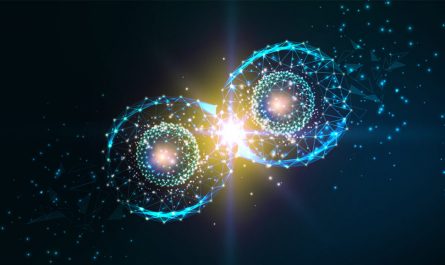When a whale dies and its body sinks into the deep sea, this does not mean the end of life. On the contrary, the giant carcass of whales will form a prosperous ecosystem in the next few decades or even hundreds of years, providing a steady flow of nutrients for various seabed creatures. As large as hagfish, sleeping sharks, deep-sea crabs, and as small as deep-sea anaerobic bacteria, they can be nourished by whale carcasses. On the dark seabed, this kind of life island formed by whale carcasses is called a whale fall.
Man is an “ecosystem” with 10 trillion microorganisms
Modern people often call themselves an island, which may be expressing a touch of sadness. But in physiology, this sentence is true-there are more than 100 million microbial communities in the human body, and the total number of microbes exceeds 10 trillion, covering bacteria, fungi, viruses, and even a small part of them from ancient times. Archaea from here.
If the human body is compared to the earth, then the skin, intestines, mouth, respiratory tract and other parts are the African savannah of microbes. They eat and live together in these places, not only relying on the nourishment of the human body, but also acting on the human body and affecting the body. Function, forming a harmonious ecosystem.
It can be said that everyone’s body is a miracle of life even more miraculous and magnificent than a whale.
Professor Jero Enray from the University of Leuven in Belgium is the world’s top microbiologist. He discovered the relationship between microbes and human depression and said: “You are not only a person, but also a walking flora.”
There are many human ancestors, and microorganisms are one of them. However, seeing this, some people may still be drumming in their hearts: What will they do to me with so many microorganisms?
What the microbes in the body do to us
First, they may change our genes.
It has been found that 8% of the sequences in the human genome are derived from retroviruses; and scientists have analyzed that 145 gene segments in humans come from bacteria, viruses and other microorganisms. In other words, the ancestors of contemporary people on earth are not entirely human, and some are bacteria and viruses.
Don’t panic first, these microbial gene fragments have entered the human genome little by little through accidental gene exchange events one after another during the long human evolutionary process.
As for the impact on the human body, it is still unclear. However, anyway, they have existed in the human genome for at least hundreds of thousands of years. They can be regarded as ancestral chromosomes.
Although there is no way for the genome, scientists are paying more and more attention to the microorganisms that are still alive on the human body. Such as the intestinal flora. Studies have found that when inflammatory bowel diseases such as Crohn’s disease and ulcerative colitis occur, the intestinal flora will also change significantly. Oral probiotics such as bifidobacteria can adjust the intestinal flora and have a therapeutic effect on many intestinal diseases. This is also the basic operation of gastroenterology and pediatrics for many years.
What is skin microecology
As we all know, the skin is also an important town where human microorganisms live. In skin microorganisms, 74%~80% are bacteria, 5%~10% are fungi, and 10%~20% are viruses. Among them, the most concerned is the role of various bacteria in skin diseases.
From the example of the intestinal tract, we know that adjusting the local microecology can treat and prevent diseases in related parts. Can this experience be applied to the skin?
Just imagine, if we can adjust the microecology of the skin surface by some means, so as to achieve the treatment of skin diseases, and even achieve the effects of whitening, anti-itching, and anti-aging, it will definitely be the scientific community’s understanding of skin diseases. A huge revolution in treatment methods.
Fortunately, more and more research results illuminate the way for human beings in the regulation of skin microecological.
10 trillion microbes live in the human body. It is inevitable that they will form cliques, form various forces, squash each other, and play a “game of power”. In some skin diseases, scientists can also achieve therapeutic effects by changing the proportion of skin microbial flora.
Skin diseases that everyone is familiar with, such as acne and dandruff (seborrheic dermatitis), have long been proved to be closely related to microorganisms, and the regulation of microorganisms is the key to treating these diseases.
In addition, although the microbes on the skin are fighting each other, when they face various pathogenic microbes and air pollutants from the outside, they can still work hand in hand to fight against the enemy and resist external aggression. They can promote the secretion of a class of substances called “antibacterial peptides” by keratinocytes, which can not only kill pathogens that are on the face with dead skin, but also have anti-adhesive properties, so that pollutants and pathogens are not easy to adhere to the skin, forming a joint A barrier in the biological sense. It can be said that skin microorganisms are human skin guards.
The regulation of skin microecology helps you prevent aging
In the much-anticipated anti-aging aspect, the skin surface flora can also play a role. As publicized on the Internet, oxidative stress is an important cause of skin aging. The bacteria on the skin surface can secrete a powerful antioxidant, which can significantly improve the oxidation of keratinocytes, thereby delaying skin aging. In addition, these antioxidants can also reduce the production of melanin, and even inhibit the growth of melanocytes. The functions are comprehensive and perfect.
In addition to anti-aging and whitening, the important role of skin microorganisms on the human body is to regulate the immune system.
Everyone knows that the immune system is the body’s guard, able to resist foreign substances and biological invasion. Unfortunately, the guards are not born to know who the bad guys are, they only know the skin microorganisms closest to them. These microorganisms stimulate the human immune system time and time again, making immune cells highly vigilant, remembering their appearance, and ensuring that they will never be soft when they encounter them in the future. The poor immune system has slowly exercised and grown through countless injuries.
Interestingly, because everyone’s skin microbiota will change with the external environment, trauma, antibiotic application and other factors, which makes everyone’s skin microbiome unique and can give their own immune system unique Stimulation and training. Using this principle, in the future, it may be possible to selectively train the immune system to be allergic or tolerant to certain substances to benefit the majority of patients with allergic diseases.
In addition, the skin flora not only acts on the skin, it can even affect the stability of the intestinal flora. A number of studies have shown that in the intestinal flora of acne patients, the proportion of probiotics such as Clostridium spp. has decreased.
In short, the regulation of skin microecology is currently one of the hot spots in the field of dermatology, and cosmetics, relying on their convenience and frequency of daily use, have become the trend of this reform. Unfortunately, although everyone knows the importance and broad prospects of this field, there is still a lack of effective control methods. Everyone can only explore in the dark and quietly prepare their own “black technology”, hoping to become the first photo. Torches that light up the darkness.
Maybe in the near future, with the help of technology, we can let our microbe babies work hard like bees, anti-aging day and night, and become the beautiful queen who can regulate our body’s microbes while talking and laughing.






